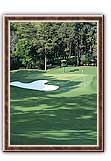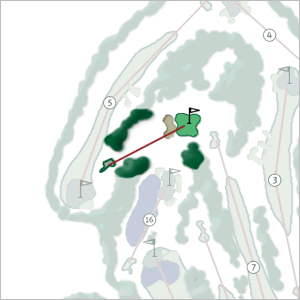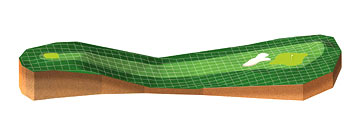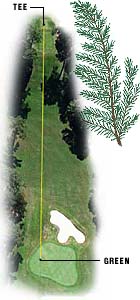| Hole Names | |
|
|
|

Hole #6JuniperJuniperus virigniana Par 3, 180 Yards |

|
||
|
An elevated tee and large target are characteristics of this par 3. A significant difference in elevation from front to back makes the pin position very important. An elevated tee looks down on a two-level green that has a large hump on right. An elevated tee looks down on a two-level green that has a large hump on right. An elevated tee looks down on this hole with a giant hump at the right of the green. The pin position at the top of the hump is one of the most difficult on the course. | |||

QuickTime AVI (2.46M) Animated GIF | |||
|
Jack Nicklaus says: Here again is a very severe green. Twice during the tournament the pin is placed on the top-right. ... It's a small area to keep the ball in. If you miss the ball left, you're going to come down to the front of the green with no chance for birdie. With the pin in the back-left or front-left you probably have the best chance for birdie by taking it to the right-center of the green and let the ball just flow down into the hole. Youíre generally hitting a middle iron off the tee here, and the key is to get the ball on the correct level of the putting surface. When the flagstick is on the left side of the green, you play for the middle of the green with a draw. When the hole is tucked back right, you play a fade. Iíve made a lot of birdies on this hole through the years and thatís always a big plus because birdies are hard to find on the first nine at Augusta. When you can make a 2 on this hole, it gives you a nice boost. Thatís what happened in í98, when I made a little run on Sunday. I gave a shot back with a bogey on the fourth, but then birdied here to regain my momentum. Looking back, I birdied the sixth hole in the previous two rounds, too, so that was a definite key for me in finishing tied for sixth place. One of the most memorable shots here occurred in 1954 when amateur Billy Joe Patton, a gallery favorite who had been the 36-hole leader that year, holed a 5-iron on Sunday. Jose Maria Olazabal wasnít as fortunate in 1991ís second round. Two pitches from off the green rolled back to his feet. He walked away with a 7 and lost the tournament by a shot. Fuzzy Zoeller says: This is severely downhill, playing anywhere from 170 to 195 yards. The key is the wind and picking the right club. Tough pin is top right. There's a 4-foot plateau to a 20-foot mound with a pretty good back to front slope. Tiger Woods says: There's a top-tier on the right the size of a bathtub -- at least that's what it looks like from the tee. I've hit 6- or 7-iron, depending on the wind, and like No. 4, if you can make four straight 3s, you're a very happy camper. Fred Couples says: It's a downhill par-3. When the wind blows, I think it's a very delicate shot. When it's calm, it's pretty simple. The green has a shelf up to the right where they put the pin two days, and I think that's probably the hardest shot to get it on that tier. If you don't get it up there, you're left with some pretty awkward putts. It's just a very good par-3. Bernhard Langer says: When you're standing on the sixth tee, it looks like you're hitting into a big green, just like at No. 5. But there are a lot of small plateaus and if you're not on the correct plateau near the hole, you're going to have to hit a tremendously difficult putt. In fact, I've seen a lot of four-putts here. Off the tee I always face a difficult club selection because the hole plays downhill and the wind swirls. Depending on the conditions, I usually wind up hitting a 6- or 7-iron. Ideally, you want to place your tee shot just short of the hole so you have an uphill putt. The toughest hole location is on the small, back-right plateau. The easiest is center back or middle back because then you have most of the green to work with. Front left is a very difficult position to get close to because most players go long and have to putt downhill. If you're near par after No. 6, which played fourth toughest last year, you're doing well. The next few holes are a bit easier challenges. While they're not pushovers, they give you somewhat of a break after battling four, five and six, Augusta's "other" Amen Corner.
| |||

Hole #6JuniperJuniperus virigniana Juniperus virginiana is a native evergreen tree. Commonly called Red Cedar, it is not a true cedar. The aromatic wood makes it popular for storage chests and other furniture. Younger trees are used extensively in the South as Christmas trees. |

|
||
fatpat Software · PO Box 1785 · Charlottesville, VA 22902 · (804) 977-1652
